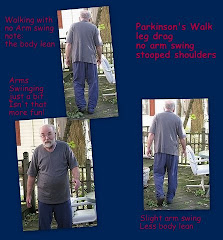Help for Balance,Tight Muscles and Sore Joints of PD
One of the early symptoms Steve developed many months before his diagnosis was Postural Instability. It is frightening not to know where your vertical or center is. We take this marvel for granted and don't realize its importance until it's gone. For those who have suffered from dizziness or vertigo, you know.
If possible, get other friends or family members to lead you or your person with PD in exercises to vary the routine. I do not make the best exercise leader for my husband because I want him to push and that feels like work to him. I am too emotionally invested and therefore have a higher frustration level; I don't always have the patience he requires. My sister is a great exercise leader because she is patient as she moves from step to step.
In the past Steve didn't do more than go through the motions especially after his Exercise Therapist told him that he didn't need to push through. Steve loved the idea; I hated it! Great therapist but for that bad idea - you do need to give exercise your all once you have learned the motions. Like dancing. And I propose rhythmic music to make your routine feel less like a regimen and more like a dance.
I do posture exercises regularly but I don't plan them. I sneak them in before I get out of bed or when I'm sitting at the computer or about to stand and cook. Mongo and Blakey stretch all the time - they know intuitively how important it is to jump successfully to all of those forbidden places.
Chair exercises should begin with back stretching followed by body twisting.
Back stretches help to strengthen those muscles responsible for posture
as well as reducing stiffness and promoting flexibility (range of motion)
And it wouldn't hurt to stretch your arms as well as your hands and fingers.
Back Stretch:
- Raise arms to shoulder height in front of you
- Bend the elbows and bring palms together in front of face with fingers pointing towards ceiling - press hands first gently together and breathe through the nose - in slowly, then hold, then out.
- Press hands firmly together while sitting up as straight as possible - you will feel this in the arms and the front of the chest and abdominal areas
- Next open arms wide - moving them apart with fingers now pointing at the walls - feel the stretch across the chest and shoulders - even in the wrists
- Now comes the tricky part - the idea is that with arms stretched in an open position, they push backwards so that the shoulder blades are pushed together as closely as possible. The stretch will be felt in the shoulders, the shoulder blades and the neck and even the chin.
- Repeat this exercise 10 times and relax
- Sit up in the chair - do not lean back - arms straight down, palms towards your body
- Still sitting as erect as possible, slowly bring arms up to shoulder level forming a cross – fingers separated. You should already feel a pull in the shoulder area.
- Now bend your arms and bring your hands to your shoulders - it may only be possible to have finger-tip contact
- Now slowly turn/twist the upper torso to the right, let your head follow the motion as you try to look over your right shoulder
- Slowly return to face forward - hands still at shoulders
- Next slowly turn the body from the waist to the left, again let the head follow to look over the left shoulder.
- Slowly return to a forward position - check posture: are you still sitting tall ?
- Stretch arms out - keeping them parallel with the shoulders and rotate arms in a small circle with the movement coming from the shoulders.
- Slowly breathe in and out through your nose and
- Repeat this exercise 9 more times
Marching in Place whether sitting or standing is an excellent exercise for freezing, balance, walking. You can march in place while holding on to the back of a chair or even your walker as long as the brakes are on or the walker is braced against immovable furniture. It is easier to get going from a march gait than a walk. You can march while at your desk or as a passenger in a car - don't try it while you are driving, however.
The back is as straight as possible in a march. Just play a Sousa march and you'll feel yourself sitting taller. The movement doesn't come as much from the spine, shoulders and hips as a walk but rather from the knee to the hips. Feet land squarely on the floor. It is easier than a walk in some ways. So march away.
For more exercises and to read about Forced Exercise to relieve PD symptoms:
Forced Exercise and other links for Dr Alberts' work
March Music you can choose your own at You Tube. Clicking on the link will open your sound track in a new window. Yes, Sousa marches are fast.. As a child, my Grandfather played many of them on the piano but slower and they work well that way.
But pop over to the Regimental Marches of the Foot Guards for slow marches and work your way up to Sousa.





























